READY TO GET STARTED?
REQUEST A FREE ESTIMATE
Fill out the form below or call (888) 466-7849 for a free, no-obligation estimate.

Centipedes and millipedes are two common household pests that are often mistaken for each other. How can you tell them apart? How can you tell if they’ve infested your home? Learn the difference between centipedes and millipedes, along with tips to prevent both of them from taking over your home.

Centipedes have elongated, flat, segmented bodies with 1 pair of legs per segment. They can have anywhere from 15 to 177 pairs of legs. They have long antennae on their heads, as well. They can come in a variety of colors but the most common species are either brown or reddish-orange. These pests are attracted to damp, dark areas like basements, bathrooms, and closets.
Centipedes are nocturnal and can move very fast, making them hard to spot by homeowners. In fact, the only real sign of centipedes in your home is spotting live pests.

Millipedes have long, cylindrical bodies with 2 rows of legs on their bodies and 1 row of legs on the front of their bodies. They grow to about 1 to 2 inches in length. These pests will curl into a ball when touched or threatened. They prefer dark, damp spaces and are often found under wood piles, under rocks, and under trashcans. When they come indoors, they can often be found in attics, basements, sheds, and crawlspaces. These pests eat damp and decaying wood particles and plants.
Millipedes are also nocturnal so spotting them can be difficult. Signs of millipedes include seeing live pests in your home and signs of structural damage. These pests will eat damp or decaying wood so look out for damage to firewood, cardboard boxes, etc.
Although centipedes and millipedes don’t pose a significant threat to humans or homes, they can be a nuisance to have around. Routine pest control can help keep these, and other common household pests, from taking over your home. Contact your local pest control company for an inspection.
How to Identify Stinging Pests in the Southeast
How To Avoid Mosquito Bites this Summer
Categories